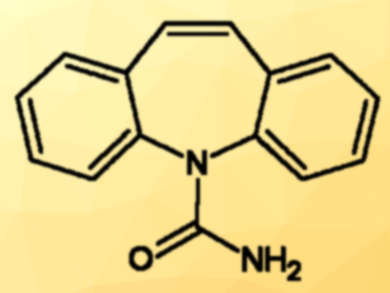Pharmaceutically active compounds can exist in different physical forms, which have different physicochemical properties, e.g., solubility or dissolution rate. These properties have a significant influence on the effect of the compound in a drug. Knowledge about the physical form of an active ingredient is, thus, important for its use in medicine.
Gareth Williams, Simon Gaisford, and colleagues, University College London, UK, have used simultaneous differential scanning calorimetry (DSC) and synchrotron X-ray diffraction (XRD) to explore the phase transitions in two related pharmaceutical materials: the anti-seizure drug carbamazepine (pictured) and its derivative 10,11-dihydrocarbamazepine.
Usually, such phase transitions are studied using only DSC, which does not give structural information. XRD can do this, but normally takes a considerable time to record a diffraction pattern, which makes it difficult to study short‐lived phases. The team showed that a simple modification to a standard lab DSC instrument allows it to be mounted on a synchrotron X‐ray source, which allows diffraction patterns to be obtained in as little as 2 s.
The conversions between the different physical forms of the two compounds were previously thought to be solid–solid transitions. The team proved this assumption wrong and showed that the conversion involved at least some melting, followed by recrystallization. According to the researchers, the simultaneous use of DSC and XRD to analyze a single sample gives new insight into phase transitions which are important for pharmaceutical chemistry.
- Polymorphic Phase Transitions in Carbamazepine and 10,11-Dihydrocarbamazepine,
Alexander E. Clout, Asma B. M. Buanz, Simon Gaisford, Gareth R. Williams,
Chem. Eur. J. 2018.
https://doi.org/10.1002/chem.201802368




